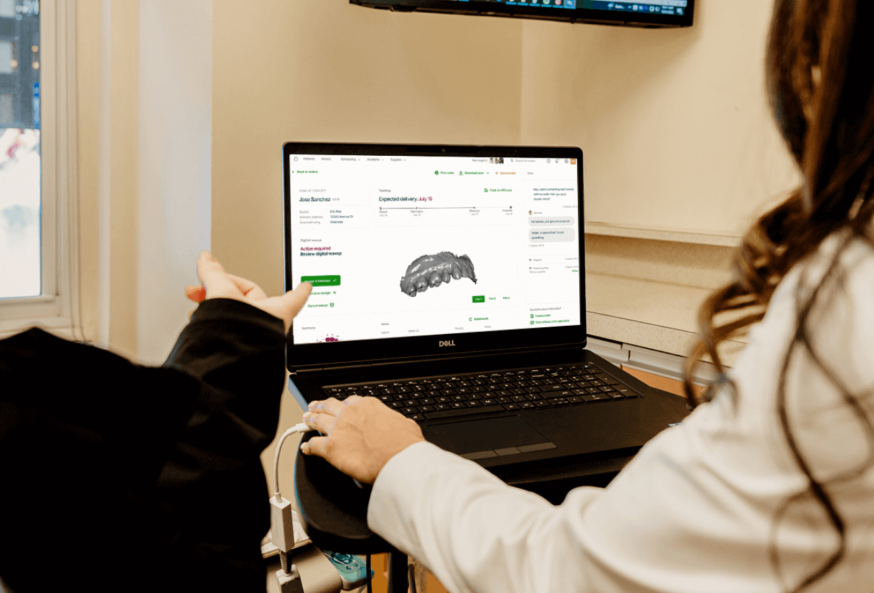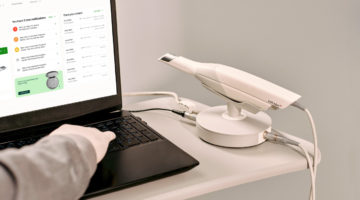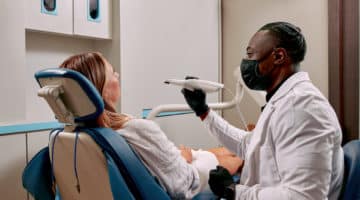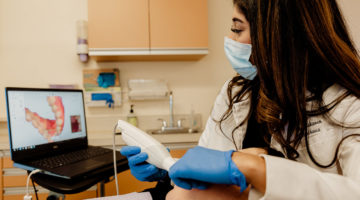Let’s be honest: historically, the dentist’s office hasn’t been a place people associated with a good time. Nearly six out of 10 adults report that a trip to the dentist is an experience they dread, because many of the traditional dental workflows are uncomfortable (if not downright painful).
What if, instead of gooey, messy alginate impressions that tie up your chair with an uncomfortable patient trying not to gag, you could replace that entire paradigm with a simple, easy-to-use, astoundingly accurate magic wand?
Well, there is indeed a wand, but it only feels like magic. We’re talking about digital dental impressions from an intraoral scanner.
In dentistry, time isn’t just money, it’s patient satisfaction, it’s your applied expertise, and it’s business growth. Digital dental impressions streamline workflows, reduce in-chair time, and produce amazing products. “I love how accurate the [digital] crowns and partials fit,” says Dr. Verne Ticknor DDS of South Haven, MI. “With the 3D scan we are making little to no adjustments! Patients are very pleased with not taking impressions and the little time they spend in the chair. It has changed our practice!”
So what is a digital impression, and how can they help revolutionize your practice? Read on to find out.
What are digital impressions and how do they work?
In simplest terms, digital dental impressions are computerized molds of the patients’ oral cavity created using an intraoral scanner. The intraoral scanning wand is inserted into a patient’s mouth where it emits and captures painless pulses of light to automatically record the size and shape of each tooth, as well as gingival tissue and bite. As you scan a patient’s mouth, the data is processed by software running on a nearby monitor–where it instantly stitches together a 3D, color, manipulable rendering of the patient’s mouth including occlusal relationships.
Once a digital impression is captured, it can be transmitted to the dental lab as fast as one would send an email. Once the lab receives a patient’s data, skilled techs utilize computer-aided design and computer-aided manufacturing (CAD/CAM) software to articulate, examine, and manipulate digital impressions to minute specifications. This means fabrication can take place with previously unimaginable speed, precision, and ease.
“When you design digitally, you don’t have to arrange each and every tooth individually,” explains Chad Van Maele, a Dandy lab tech with over a decade and a half of fabricating dental prostheses. When using traditional impressions to fabricate a prosthetic, an adjustment of a just few millimeters may add hours to a workflow. Not so with digital dental impressions. “The software auto-generates all the teeth in perfect occlusion,” Van Maele says. This means that, not only do you receive work back from the lab faster, but the results are more accurate.
So a digital impression is also the key to your practice’s future.
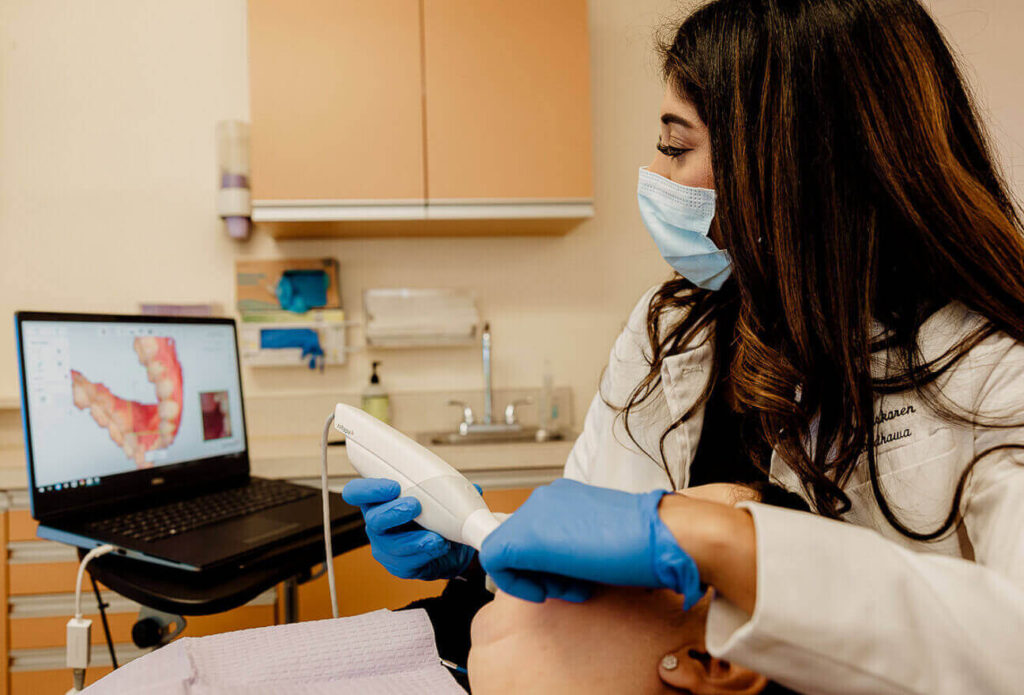
Applications of digital impressions in dentistry
Compared to traditional methods, a snapshot of patients’ oral health can be taken faster and more accurately with digital impressions. Dentistry, however, is about much more than diagnostics.
Digital impressions can be used to create a baseline to which treatment results may be directly, visually compared. “Many patients were fascinated by the technology,” says Dr. Ritesh Shah of California’s Sorento Smiles Dentistry when discussing digital impressions. In dentistry–an often aesthetically-motivated arena–professionals like Dr. Shah know that patients need to see results. “More than one [patient] described the process of being able to see [their] teeth as they were before and after as a huge plus… Seeing is believing.”
Beyond their utility as metrics, dental impressions are the starting point for many different types of prosthesis or restoration, including:
While you are used to the traditional workflow rest assured that the digital impression dentistry process is simple and straightforward. “After 30 years of being very happy with my own dentistry, to my surprise [with digital dentistry] I’m better than ever before,” says Dr. J. Trovato of Trovato Family Laser Dentistry in Kearny, NJ. “I save on impression materials, get lab work back faster, and I take advantage of new technology,“ which, Dandy’s survey of patient priorities tells us, is a major factor driving patient satisfaction. Further, when a denture is lost or broken, the traditional mold needs to be retaken, whereas digital impressions are saved, well, digitally, mitigating the risk of either.
The benefits of bread-and-butter dentistry are obvious when you go digital. Impressions in dentistry, however, can be a launching pad for many more different diagnostics and treatments, including:
- Wellness scans
- Tooth alignment planning
- Splints
- Mouth guards
- Sleep apnea appliances
Benefits of digital impressions
Much has been made of the speed with which digital impressions are taken, so exactly how long do digital impressions take? “Dandy has allowed us to cut down chair time 15-20%,” attests Dr. Ashley Ciapciak of Brede Ciapciak Dental in Needham, Massachusetts. “Now I can see four more patients in my day because I can scan in about a minute, rather than waiting for my impressions to set.” Dr. Ciapciak’s experience is not atypical–full digital impressions are typically completed in 2-5 minutes.
But aside from speed, there are many more life-changing benefits of digital impressions. Dentistry is, after all, the business of smiles.
Improved patient satisfaction
Digital impressions in dentistry create a better experience for patients while also improving treatment outcomes. No one enjoys gagging on goop during traditional impressions. As a no-gag alternative to traditional tray impressions, digital impressions are much more comfortable, not to mention faster. Moreover, many patients are impressed by the technology–a factor that should not be taken for granted when considering your business’ bottom line.
Efficient communication with the dental lab
Traditional impression procedures are characterized by substantial back-and-forth between the clinic and the lab. Digital impressions enable the lab to spot an issue immediately and request a secondary impression—a real-time workflow that often prevents the hassle of scheduling a second impression appointment.
More efficient restoration turnaround times
Digital impression images get sent to the dental lab electronically. As a result, you don’t have to go through the hassle of shipping physical impressions in the mail and paying the associated shipping costs. Your patients can also enjoy a reduced turnaround time in receiving their restorations.
Digital records
With digital impressions replacing the traditional impression paradigm, you no longer have to store fragile stone molds; patients’ detailed scans are readily accessible with many digital workflows. That not only means less burden on you to store the records securely, but an end to the risks posed by shipping and logistics.
Improved accuracy
Intraoral scanners capture every small intricacy of the oral cavity, leading to accurate 3D models and bite registration. This leads to better restoration results and significantly fewer redos than with traditional impressions. One 2020 study found that 64.5% of traditional impressions a lab received were inadequate or unacceptable.
Simplified expenses
When you take digital impressions, you no longer need to constantly restock your office with costly dental trays, putty materials, and mixing bowls.
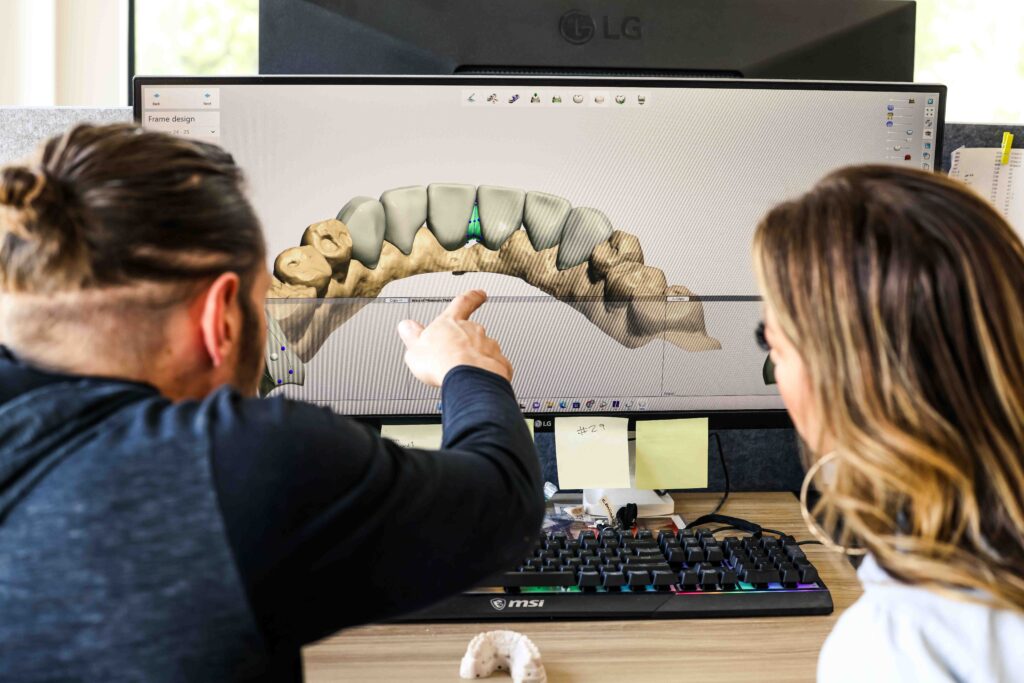
Taking digital impressions in different fields of dentistry
As previously stated, many dental treatments can benefit from digital dental impressions. In dentistry, a rising technological tide lifts all boats; no matter your practice’s specialization, digital impressions can be the key to unlocking its future. Here’s a deeper look.
Orthodontics
Orthodontists can utilize digital impressions to generate precise 3D models of teeth for treatment planning and appliance placement. Orthodontists can analyze the digital models to determine the optimal placement of braces, clear aligners, or retainers. It also speeds up the process of fabrication, allowing for more accurate appliances to reach customers faster.
Dentures
Denture creation relies on accurate impressions, so a workflow that simplifies and speeds that process–while also making patients more comfortable–is ideal. Additionally, digital impressions mean a massive reduction in back-and-forth between the lab and your practice as well as the ability to more easily determine VDO and perform bite registration in fully edentulous patients.
Prosthodontics
Digital impressions facilitate prosthetically-driven implant planning. Digital implant impressions and cone beam scans can be combined to comprehensively plan treatment and present the plan to the patient visually. In a fully digital workflow, doctors may also utilize the digital implant scan to create a surgical guide, potentially reducing operating time and enhancing surgical precision.
Digital impressions vs. traditional impressions
To understand the difference between traditional and digital impressions in dentistry, we can simply let the respective workflows speak for themselves:
Traditional impressions workflow
- The patient’s teeth are cleaned and prepped.
- The dentist prepares impression materials (typically alginate or polyvinyl siloxane)
- The dentist loads impression materials into the dental stock tray.
- The preliminary impression is captured by inserting a tray into the patient’s mouth, pressing it firmly against the teeth, and waiting a few minutes as the putty hardens.
- The dentist carefully releases the dental tray.
- The tray is inspected for any defects. If any are present, the process must be repeated.
- The impression material is poured into dental stone, and a dental vibrator removes air pockets.
- The stone mold is allowed to cure
- The stone mold is inspected for any imperfections. If any are found, steps have to be repeated.
- The stone mold is shipped to the lab.
Digital impressions workflow
- The patient’s teeth are cleaned
- The dentist performs a digital scan using an IOS
- The dentist reviews the scan with the patient
- The digital impression is sent to the lab electronically.
Simplify your practice with digital impressions by Dandy
Digitized equipment and procedures are raising the bar for what’s possible in modern dentistry. While patient care still requires a human touch, better clinical outcomes and increased efficiency can be improved dramatically when you adopt new technology like digital impressions. Dentistry as a field overall must always aim to improve the patient experience.
For many dental professionals, digital impressions represent the first touchpoint along the path to a modern practice. It’s turning a common procedure that patients almost universally dread into a fast, pain-free process with a bonus ‘wow’ factor. Dandy is here to help you break the mold. Our mission is simple: to simplify your workflow and improve outcomes by taking the entire dental process digital, from beginning to end. If you want to learn more, schedule a call with us today.
